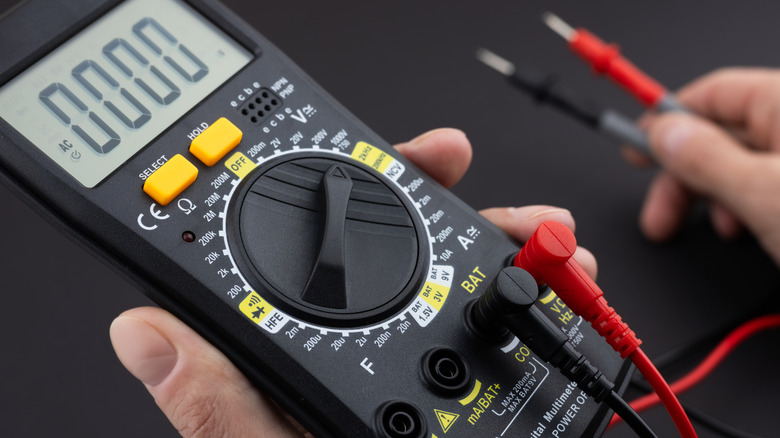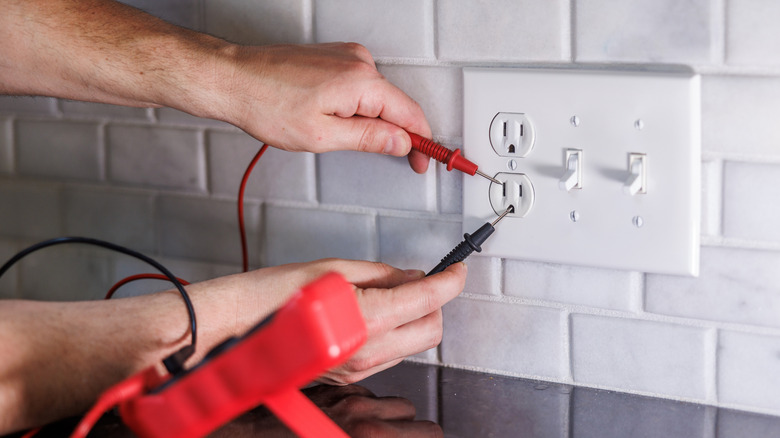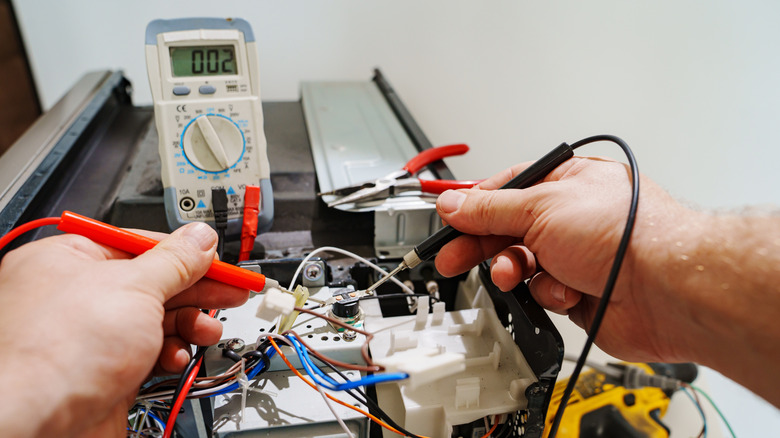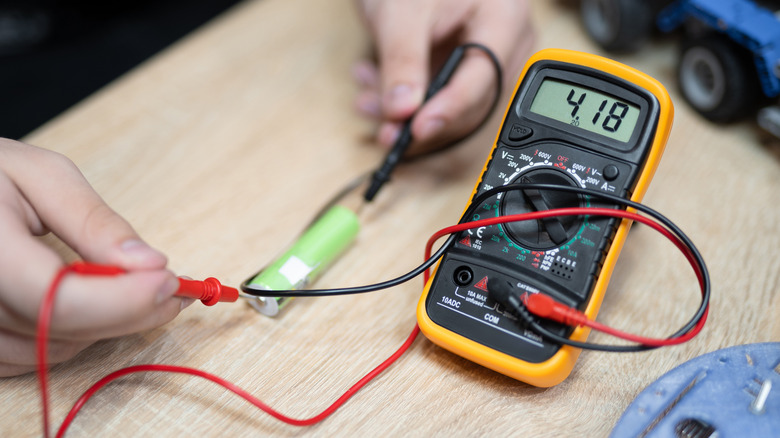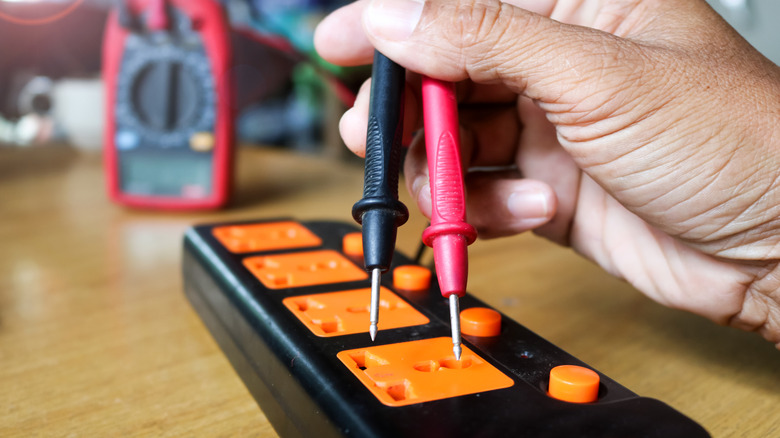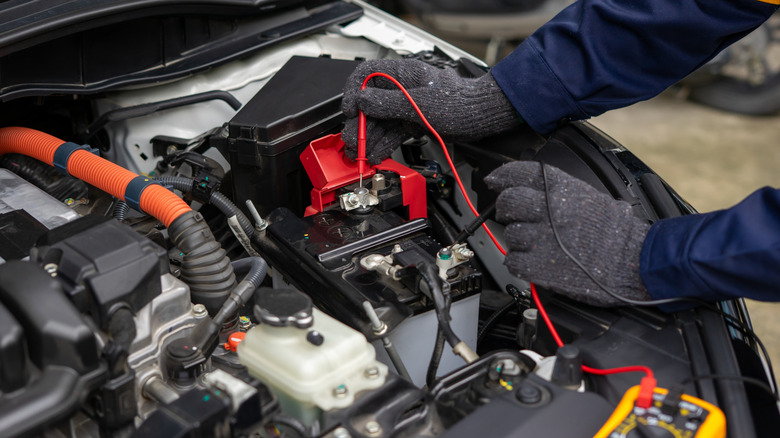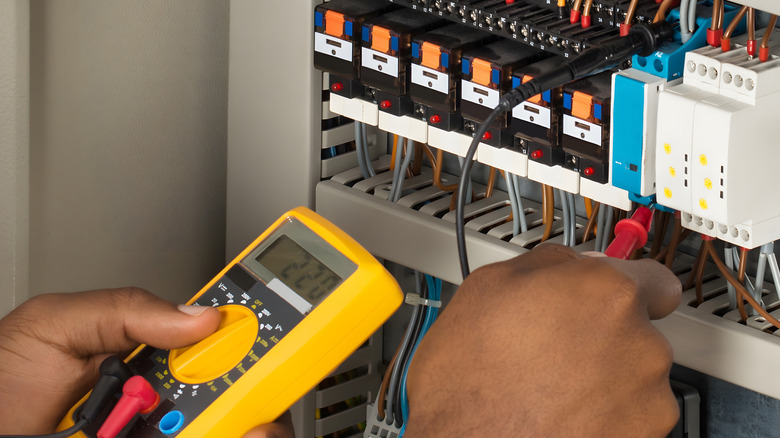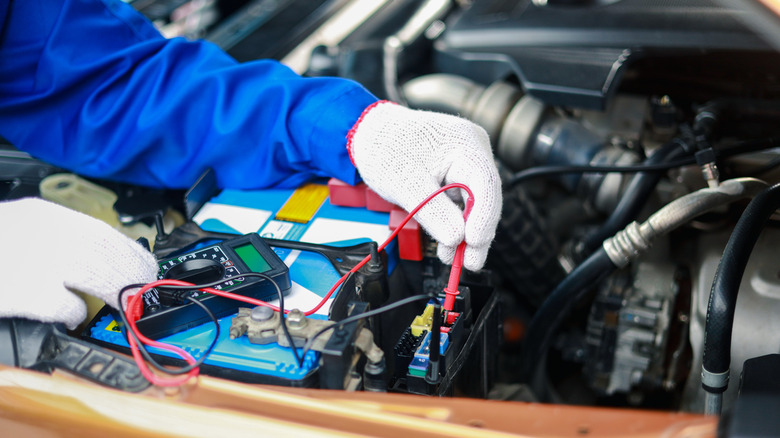7 Handy Ways To Use A Multimeter Around The Home And Garage
We may receive a commission on purchases made from links.
One tool you'll find stashed in all the best electrician's tool backpacks is a multimeter. Most modern multimeters are of the digital variety, powered by some type of internal battery and equipped with a display you can read the results on. The simple, often more affordable multimeter option is an analog multimeter, which doesn't require batteries to operate, but is known to be somewhat less accurate than digital alternatives.
You don't need to be an electrician or a mechanic to reap the rewards of owning a multimeter. It's a simple tool to learn how to use, thanks to a plethora of online guides and video tutorials, and it can save homeowners both time and money. Multimeters can rescue batteries or light bulbs you thought were destined for the trash and help uncover a minor issue in a major appliance before you carve out time and money for an electrician to check it out.
If you're still shopping for a high-quality multimeter, check out our ranking of the most popular multimeter brands. Or, if you already have a multimeter in your tool kit, read on to see how you can get the most use out of it around your home and garage.
Check outlets or switches before calling an electrician
One of the simplest ways you can use a multimeter in your home is to check faulty electrical outlets or switches. If you can identify a troublesome wire that can easily be replaced, you can save yourself the hassle of calling an electrician and potentially forking over a few hundred dollars. For your own safety, make sure that your multimeter doesn't have any obvious damage prior to getting started, and adjust it to the voltage AC setting. It's also a smart idea to wear insulated rubber gloves when working with anything electrical.
Connecting the black (or neutral) multimeter probe with the neutral wire in an outlet, identified by the large vertical opening, and the red (or hot) probe with the hot wire, identified by the small vertical opening, should result in a reading of around 120 volts. Touching the black probe to the ground wire through the semi-circular opening and the red probe to the hot wire should deliver a similar reading.
Connecting the black probe to the neutral wire and the red probe to the ground wire should deliver no result, and if you're seeing a reading around 120 volts between these two wires, it can indicate a short in the circuit or an incorrectly wired outlet. If you learn better by seeing rather than reading, there are some great video tutorials online to show exactly how to use a multimeter on an outlet or a light switch.
Identify potentially simple fixes with broken electrical appliances
Similar to testing a potentially problematic outlet or switch, you can use a multimeter to identify issues with electrical appliances in your home. Major electrical appliances, like refrigerators or clothes dryers, are expensive to fully replace, and knowing how to use a multimeter to pinpoint where the issue is can save you quite a bit of money. For example, you may need to replace a heating element in a dryer that could cost less than $100 rather than spend $400 to $1,000 on a brand-new dryer.
Even if you don't want to do the repair yourself, a multimeter can potentially provide you with the knowledge of which part of your appliance is malfunctioning, so you know whether someone is trying to overcharge you or fix pieces that aren't broken. Of course, it's worth noting that service professionals generally have a better understanding of appliances they fix repeatedly than the average homeowner, but having a multimeter on hand would allow you to double-check whatever a service professional indicates is wrong with your appliance.
For amateur DIYers looking to save money, using a multimeter for the first few times can be an intimidating experience. The easiest way to get started is by heading to YouTube and searching "multimeter" along with the appliance or specific component of your appliance that's giving you trouble, like an ice maker in your fridge, a standalone air fryer, or an oven temperature sensor.
Check batteries before throwing them out
If you have a drawer full of old batteries that may or may not have any juice left in them, testing them with a multimeter is a fast and easy way to identify dead batteries among a sea of good ones, or vice versa. Of course, you could always put batteries in a TV remote to see if they work that way, but you're often testing two at a time with this method, and there's no way to tell exactly how much charge a battery has left in it, but you can absolutely get this info from a multimeter.
To test home batteries, your multimeter needs to be set to the DC voltage function. There should be a figure on the side of the battery that you can use as a guide for the figure to set on your multimeter. For example, Duracell AA batteries hold around 1.5 volts at full charge, so if you were testing these with a multimeter, you'd set the voltage range max to around 2 volts. Touch the black probe to the negative end of the battery and the red probe to the positive end of the battery, and you should see a voltage result between 0 and 1.5 volts, with numbers closer to 1.5 volts indicating full charge.
Test continuity in extension cords
If you found an old extension cord tucked away in a closet or a dusty attic, don't throw it away just yet. Extension cords are designed to be durable, so even if it's been unused for years or exposed to extreme cold and heat, it could still be functional. If you have a multimeter, you can verify that before plugging any of your precious electronics into the extension cord and potentially damaging them.
Every time you use your multimeter, ensure you check it over for any damages and wear proper attire while using the tool, including shoes with rubber soles and rubber or insulated gloves. Then, make sure the extension cord is unplugged before testing it. Turn your multimeter to the resistance setting, often indicated with an ohm symbol, or the Greek omega letter. Then, you're ready to test continuity.
Insert the red probe into one of the holes in the extension cord's socket end, and the black probe into the corresponding prong on the cord's plug end, and you should see a reading of around 0.7 to 1.0 ohms to indicate no issues. You can repeat this with the other two holes in the socket and their corresponding prongs on the other end, and if you see a similar result, there are no continuity issues with the extension cord, and it's good to use.
Check your vehicle's battery and alternator
A multimeter isn't limited to operation within your home. There are plenty of ways you can use a multimeter on your vehicle as well, like checking how well your car battery is retaining a charge, making sure your alternator is still in tip-top shape, and identifying blown fuses.
According to AutoZone, a standard car battery that's fully charged and healthy should deliver a reading of around 12.6 volts when your vehicle is turned off and the battery is inactive. In addition to making sure your vehicle has been off for at least an hour (or even better, overnight), give your multimeter a check to ensure it's not cracked or otherwise damaged before testing the battery and set it to measure DC voltage. Then, remove the battery's terminal covers, touch the positive, red probe to the battery's positive terminal and the negative, black probe to the negative terminal. If you get a reading of lower than 12.6 volts, the battery may not be holding a charge, or it could have a bad cell.
To test a gas-engine vehicle's alternator, you can perform the same battery test outlined above, but with the car running. However, take extra precautions when performing this test, as there are actively moving parts and an electrified system to be aware of. When your vehicle is running, your battery should produce a reading between 13.5 and 14.5 volts. Any lower than that is cause for concern.
Quickly test fuses and light bulbs
Fluke, a company that specializes in manufacturing professional electronic test tools and software, makes the process of testing fuses seem incredibly simple, even if you're an amateur DIYer. After putting on safe shoes and insulated gloves and making sure whatever you're testing fuses on is powered off, turn your multimeter to its continuity setting.
With your multimeter on and ready, touch the black and red probe ends to the two metal ends of the fuse you're trying to test, and you should hear a beep from your multimeter if the fuse is in good shape. Depending on whether you're testing a fuse for your vehicle, home, or an appliance, the metal ends could look more like caps or prongs, but there will always be two metal pieces on the left and right sides for you to test.
A multimeter can also come in handy if you have multiple unboxed light bulbs stored in a drawer somewhere in your home or garage. Set the multimeter to its resistance setting, indicated by the Greek letter Omega, or the ohm symbol. Then, touch one probe to the button at the bottom of the bulb you're testing, and touch the other probe to the metal base that touches the bulb's glass housing. According to Batteries Plus, a working incandescent bulb should read above zero ohms and a working fluorescent bulb should read between 0.5 and 1.2 ohms.
Potentially diagnose a sensor malfunction in your vehicle
There are quite a few vehicle sensors you can test with a multimeter from the comfort of your own garage. If you still have your vehicle's manual, that'll be a huge help with this process, as it will show specific target values for sensors you'll be checking. If you no longer have access to the physical manual, you can probably find a PDF version online by searching your car's make, model, and year.
According to Fluke, an electronic test tools manufacturer, one of the most common vehicle sensors that needs to be tested is the Oxygen (O₂) sensor. A bad Oxygen sensor can cause your vehicle to fail an emissions test and contribute to issues with acceleration and poor gas mileage. While it's possible for amateurs to carry out a sensor test with a multimeter, the process isn't simple. Fluke has a detailed guide to measuring O₂ sensor voltage with a multimeter, and there are multiple video tutorials online if you'd prefer to see the process instead.
Other sensors that you might need to test over the life of your vehicle include the Mass Air Flow (MAF) or Manifold Absolute Pressure (MAP) sensors, the Throttle Position Sensor (TPS), and the Engine Oil Level sensor. Similarly, to test these sensors, you can find a step-by-step written guide through websites like Fluke or a video tutorial through YouTube.
